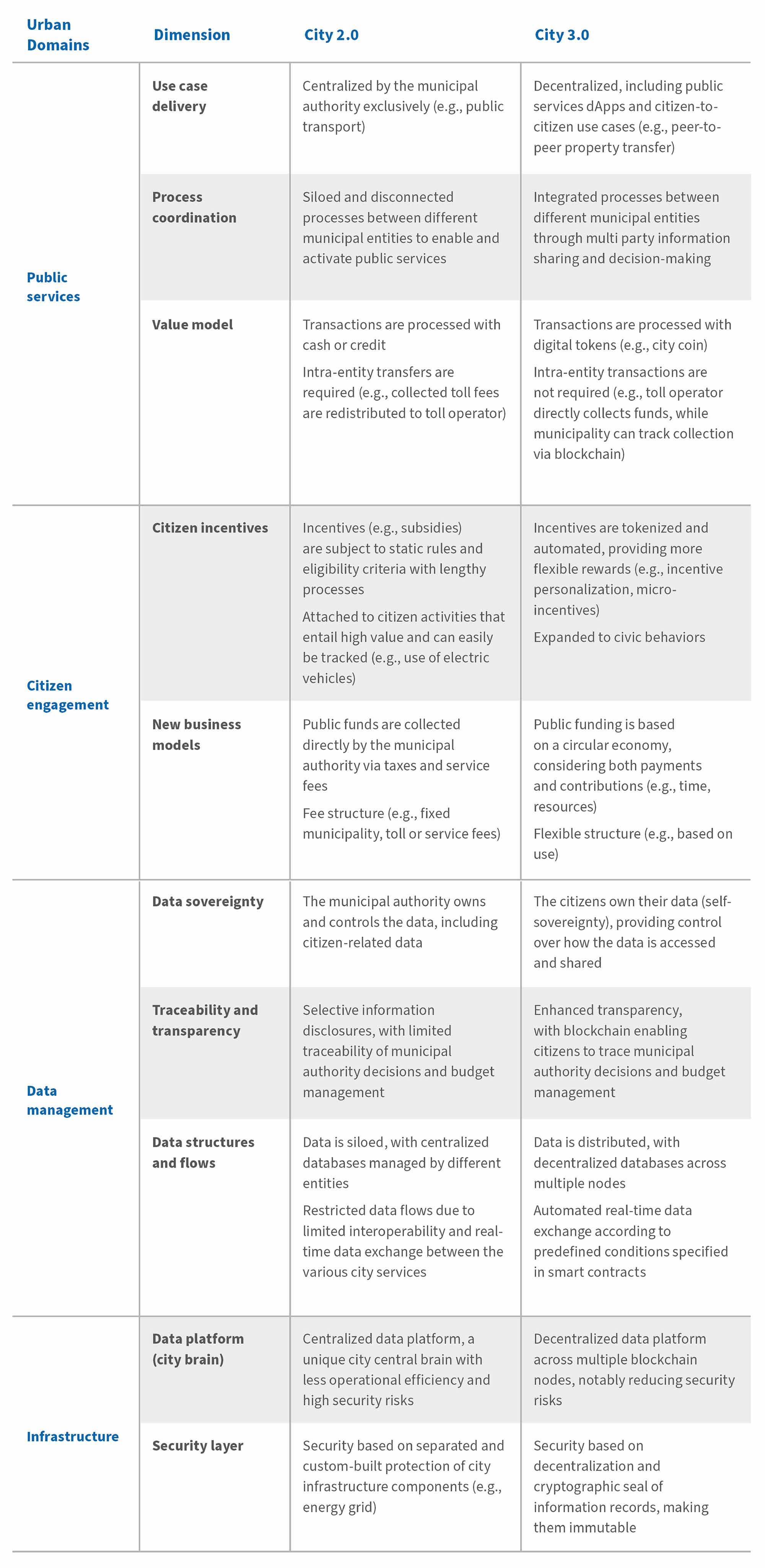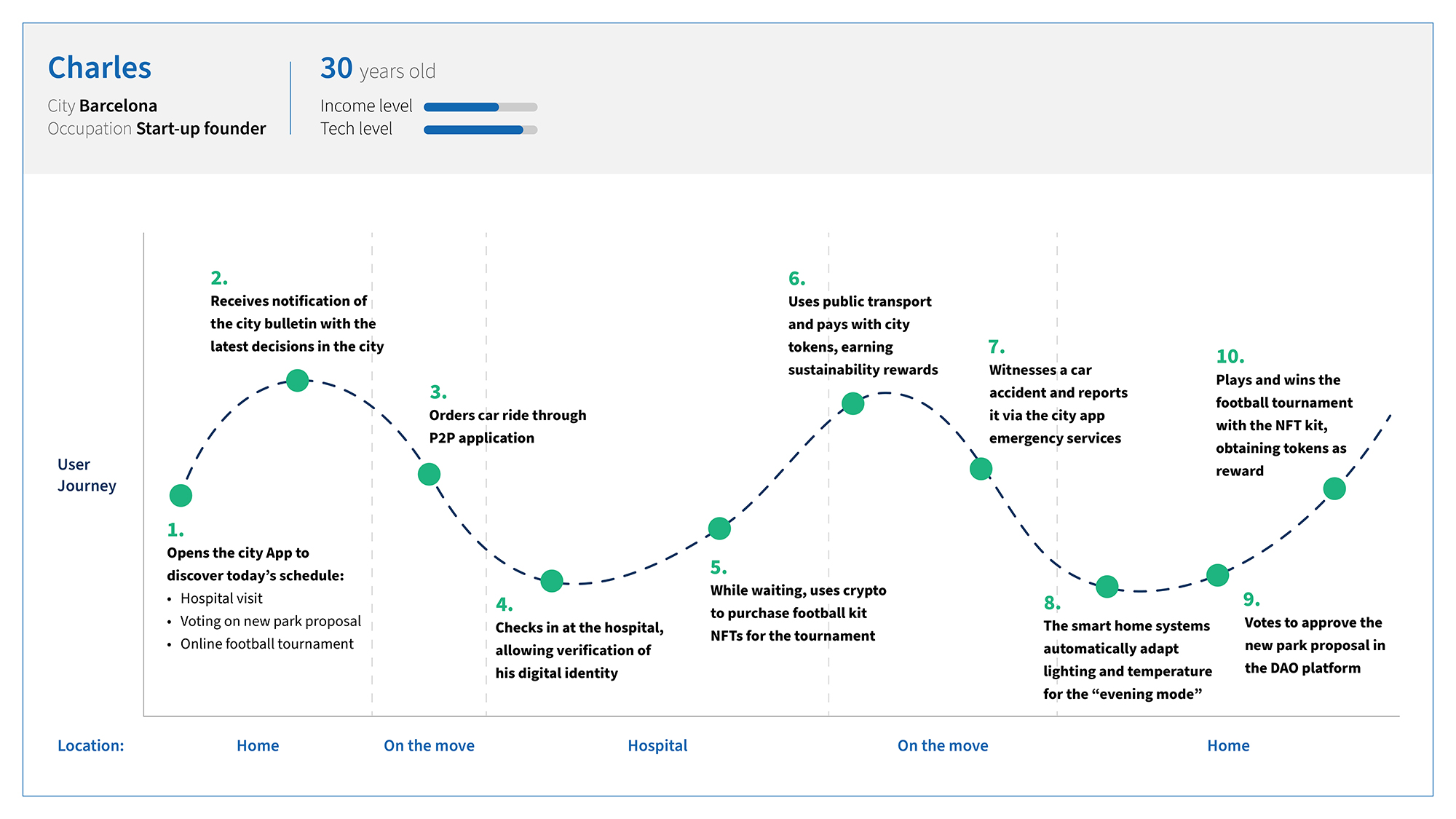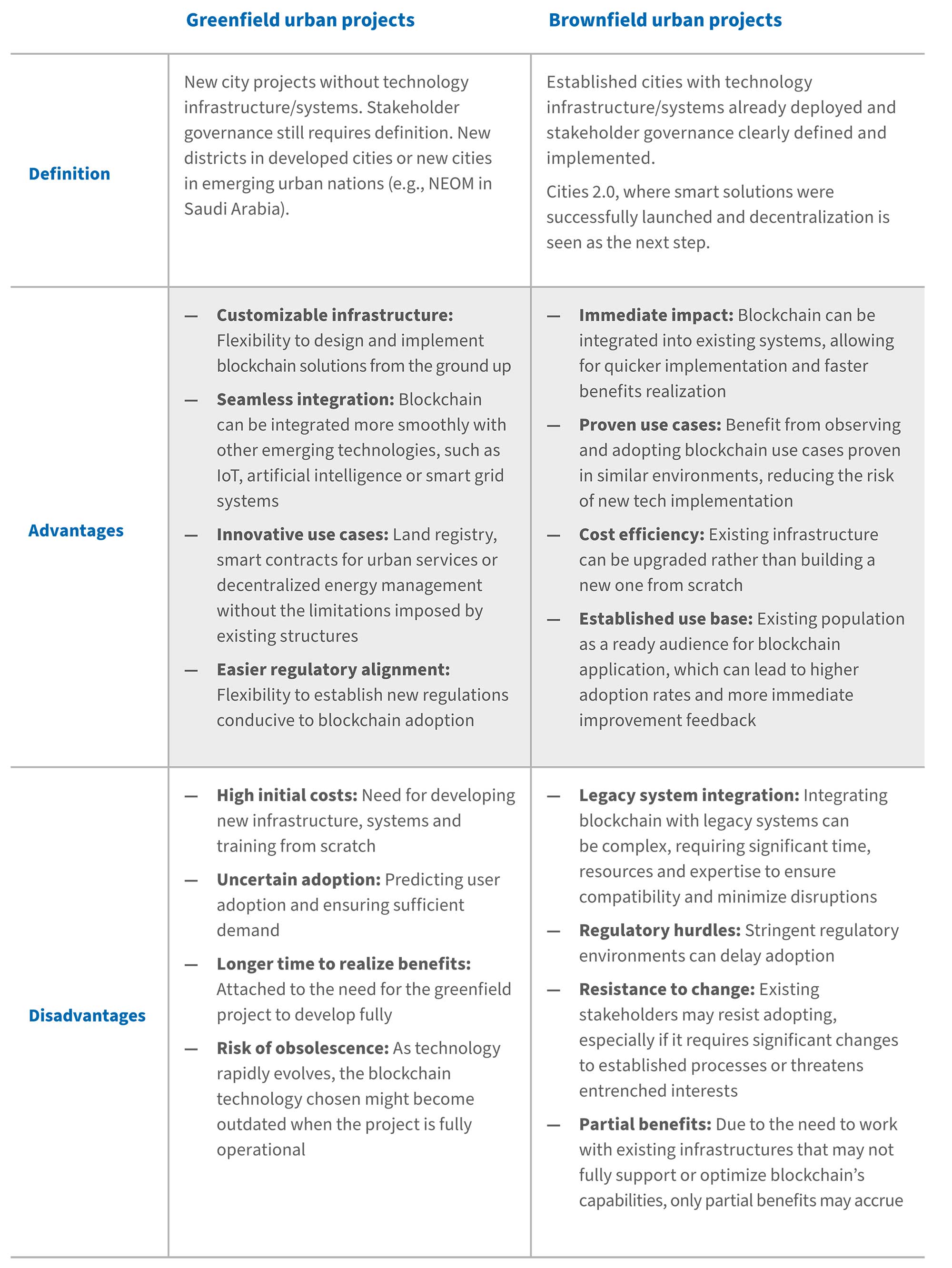Reshaping Smart Cities with Web3
-
November 29, 2024
DownloadsDownload Article
-
In the digital era, the concept of a city has evolved from large urban settlements to “smart cities” that have advanced, technology-powered infrastructure and conveniences. As more cities work to incorporate “smart” features, Web3 will play a role in further shaping the cities of the future.
The Evolution of Cities
City 1.0: The baseline–large groups of people living together for economic, social and security reasons; 1.0 cities are affected by urban challenges with limited public solutions (congestion, pollution, inadequate housing inventory, etc.).
City 2.0: The integration of modern technologies such as the Internet of Things (“IoT”) and advanced data management techniques significantly improves the quality and coordination of urban services. Municipal authorities have focused on deploying centralized smart city solutions. Inherent challenges remain, particularly regarding security, citizen privacy and addressing the digital divide.
City 3.0: The next evolution leverages Web3 and other decentralized technologies such as blockchain to empower participants, ensure transparency and security of the smart city’s data layer, and enhance efficiency across functions within the city. This advancement requires a welldefined stakeholder governance model, trusted data integrity and flexible infrastructure.
Transformative Advancements for the Future
The seamless integration of technology, connectivity and data layers has enabled the City 2.0 phase. The different layers allow users to benefit from smart use cases such as intelligent traffic control or easily accessible citizen services (e.g., online bill payment). The layer that enables the city’s “intelligence” is the data management platform operated by the municipal authority.
A City 3.0 will seamlessly benefit from closely integrating decentralization and blockchain with IoT and artificial intelligence, significantly enhancing several key urban domains outlined here.

This framework highlights how Web3 has the potential to improve smart city management and accessibility. Below is a detailed view of how Web3 solutions are being adopted, impacting smart city services, digital transactions, citizen participation in city decisions, and upgrading city data management and infrastructure domains.
Public Services
- Use case delivery: Decentralizing smart city use cases through blockchain enhances activation and delivery by providing a secure, transparent and tamper-proof environment.
— Distributed Applications (“dApps”) for public services: Using smart contracts running on blockchain, dApps can automate and streamline public services (e.g., public infrastructure management, energy generation and distribution, allocation of public funds and subsidies).
— Citizen-to-citizen use cases: Utilizing blockchain to maintain and verify transactions, certifications, licenses and permits issued by the city enables peer-to-peer (“P2P”) services. For instance, a citizen who is purchasing a land plot can verify the title deed of the seller and conduct a P2P transaction to purchase the land; the record is updated in the decentralized platform for others to verify.
— In parallel: IoT sensors will monitor different subsystems in real time. These data will rely on decentralized infrastructures and AI will analyse the data to manage public services like waste management, traffic control and energy usage. - Process coordination: Integrating processes between public entities optimizes the delivery of public services by enabling multi party information and decision sharing under predefined rules (e.g., car accident data is shared with the police, closest hospital and traffic authority). The improved interentity communication minimizes delays, enhances resource allocation and ultimately leads to more
responsive urban services.
AI algorithms optimize the multi-party information sharing and decision-making processes, relying on a secure and transparent platform based on blockchain technology. - Value model: Leveraging blockchain technology allows for decentralized financial transactions. Service providers can directly collect payments using digital tokens without the need for intermediaries or intra-government fund transfers. The blockchain’s transparency and immutability enables the realtime tracking of transactions by relevant authorities, eliminating the need for centralized fund collection and redistribution. This reduces administrative costs and speeds up transaction processing.
For instance, when a citizen pays a toll, the funds are immediately available to the toll operator, while the authority can monitor the transaction for compliance and financial reporting purposes without needing to manually intervene or process the funds.
Citizen Engagement
- Citizen incentives: Introducing token-based reward systems encourages positive, sustainable behaviours and community participation. Instead of rigid, onesize-fits-all incentives, the municipal authority can
offer rewards that are flexible and personalized to each citizen’s behaviour. The rewards are distributed automatically and transparently without the need for bureaucratic approval processes common in the City
2.0 model.
This results in a broadened scope and inclusivity of incentivized activities. For instance, citizens could earn tokens for participating in sustainable practices (e.g., reducing water usage, recycling, cycling instead of driving), engaging in community service (e.g., volunteering), or buying products locally sourced. These tokens are then redeemable for products and services or for contributions to different initiatives (e.g., charitable causes). - New business models: Public funding models optimized with AI and that leverage the principles of the circular economy include:
— Micro-contributions: Transactions for public services happen automatically in real time. These micro-contributions from citizens create a continuous flow of funds that supports public services and infrastructure, reducing the city’s reliance on tax collection. Blockchain allows for flexible tariff systems, which can provide fairness for citizens, as transactions are generated based on actual usage and associated costs to the city’s infrastructure (e.g., toll fees calculated based on the distance driven, factoring real-time data such as traffic conditions and environmental impact).
— Crowdsourcing: Citizens might also participate in funding initiatives for specific city projects. For instance, a community-driven park renovation or local art installation could be partially funded by citizens, earning rewards or recognition in return. This approach not only diversifies funding sources but also fosters a stronger sense of ownership and engagement among residents.
Data Management
- Data sovereignty: Providing full ownership of data enables citizens to determine how their data records are used, supporting data protection and verification at the same time. Decentralized identity (“DID”) initiatives run the digital identities of citizens on a blockchain ledger and enable access to government services, transfer of documentation and other services.
- Traceability and transparency: Recording the decisions and expenditures of the municipal authority on a blockchain would provide transparent and immutable records. This would enhance the accountability of government officials, reduce the potential for corruption and allow for better oversight of public spending. Citizens could access comprehensive information disclosures of public authority’s activities, including allocating and using funds and oversight of appropriate and efficient use of tax revenue.
- Data structures and flows: Decentralizing the city’s data management layer entails distributed networks across multiple nodes. This approach allows greater resilience, security and scalability, as data is not reliant on a single point of failure.
Data flows are managed and analysed using AI, are highly automated and occur in real time. Decentralized data management and smart contracts automatically trigger data exchanges when predefined conditions are met. For example, traffic management systems, public transportation and emergency services can all share data instantaneously, enabling a coordinated response to incidents.
Infrastructure
- Data platform (city brain): Operating a decentralized data platform improves operational efficiency in several ways. First, data is shared and accessible across multiple nodes, reducing data flows on processes involving multiple parties and enabling faster, more responsive decision-making. Second, because each node can operate autonomously, the system as a whole is more adaptable to changes in data volume and complexity, ensuring that city operations can scale without experiencing bottlenecks. Furthermore, maintenance or upgrades can be performed on individual nodes without disrupting the entire system, minimizing downtime and operational risks.
— Security layer: Shifting the smart city security paradigm from custom-built and component-specific measures to an approach based on the immutability of records with decentralization and cryptography includes the following.
— Decentralization: The decentralized architecture across multiple blockchain nodes enhances security by eliminating single points of failure, making it much more difficult for attackers to compromise the system. Even if one node is breached, the decentralized nature of the network ensures that the integrity of the overall system remains intact.
— Cryptography: Cryptography ensures data confidentiality, integrity and authenticity. Every piece of data is recorded on the blockchain, encrypted and linked to the previous transaction, creating an immutable chain of records. This immutability makes it nearly impossible for attackers to alter or delete records without detection.
A Day in the Life of a City 3.0 Citizen
How to Make the Transition to City 3.0
A cohesive smart city project orchestration envisions project definition, implementation and operation phases. This approach is even more critical when implementing innovative decentralized technologies in City 3.0 due to the rapid evolution of the technologies involved and the number of stakeholders (citizens, public authorities, technology vendors, infrastructure providers).
City 3.0 projects might differ significantly. It is essential to identify the starting point of the project, as detailed in the following table.
Once the starting point is well identified, the project will typically go through the following phases.
Phase 1: Project Definition
There are five main elements to focus on in the project definition phase. These include:
- Project objective: Determining the project objective between economic targets (e.g., focusing on financial profitability) and/or social goals (e.g., addressing community needs) requires proper delineation and prioritisation to ensure long-term success.
- Business plan: Developing a business plan that quantifies the upfront cost requirements and long-term economic viability ensures the project is financially feasible and sustainable.
- Stakeholder governance model: Clearly defining the stakeholder governance model (roles, responsibilities and decision-making process) is essential to ensuring transparency, accountability and effective collaboration throughout the project lifecycle.
- Regulatory framework: Complying with local, regional and international regulations and assessing the potential impact on the project’s scope, timeline and feasibility. It is essential to understand and integrate regulatory requirements early on to mitigate non-compliance risks and avoid potential delays.
- Social equity: Addressing social equity questions raised by decentralised technologies, particularly the digital divide of users without access to the Internet. The project must ensure equal access to technology and services for all segments of the population, especially underserved communities.
Phase 2: Project Implementation
The main considerations in the implementation phase are related to the project’s technical deployment, such as:
- Ecosystem of vendors: Defining the ecosystem of vendors and establishing a transparent operating model for them comprises coordinating and setting responsibilities across multiple vendor layers. Examples of vendors include decentralised technology platform providers (e.g., blockchain infrastructure providers), IoT and hardware manufacturers, cloud computing providers, smart contract developers and cybersecurity firms.
- Progressive implementation: Deploying and connecting the building blocks, allowing for initial use cases, requires a staging environment or a technology sandbox for rapid prototyping and validation.
- Systems integration and interoperability: Ensuring decentralised systems are correctly integrated with legacy non-decentralised ones to achieve system interoperability.
- Infrastructure scalability: Scaling considerations should address increasing data volumes, ensure network performance and maintain security. They should also support cost-effective expansion, smooth integration with legacy systems and adaptability to rising urban demands.
- Security vulnerabilities: Addressing security risks, especially within smart contracts or decentralised applications, is particularly important in the implementation phase due to vulnerabilities related to the technical deployment of solutions.
- Data privacy and compliance: Ensuring compliance with data privacy regulations (such as GDPR in the European Union) requires the integration of additional safeguards to protect sensitive data. This may involve rethinking data-handling practices and implementing robust privacy measures to meet regulatory requirements and protect user information.
Phase 3: Project Operation
The operations phase entails a paradigm shift related to user awareness and adoption, as well as operational set-up. Steps include:
- User awareness: Ensuring user awareness of these relatively new and complex technologies is essential. Both citizens and city officials must properly understand the functionalities of decentralised technologies and their benefits for the city. Comprehensive education programmes and clear communication channels must be established.
- Stakeholder adoption: Encouraging users to adopt Web3 technologies requires simplifying the user experience to make the solutions intuitive and transparent (regardless of technical expertise). This helps overcome low adoption rates due to unfamiliarity, concerns about security, or the inconvenience of adopting new tools (e.g., cryptocurrency wallets).
- Environmental impact: Assessing the operational energy-intensive demands of blockchain technologies and their potential conflict with the city’s environmental sustainability goals. As cities strive to reduce their carbon footprints, exploring energy-efficient blockchain alternatives, such as proof-of-stake or other consensus algorithms, becomes imperative.
- Operational dynamics: Managing a decentralised infrastructure demands a shift in the operating model. The transition from centralised to decentralised systems opens the door to improved resilience and flexibility. Although decision-making may initially be slower due to the new mechanisms and the need for consensus, this inclusive approach ensures the involvement of all stakeholders and leads to robust and well-rounded outcomes. Maintaining and upgrading systems becomes a collaborative effort.
- Trust and ethical concerns: Fostering citizen trust in decentralised governance models can be achieved by ensuring that data privacy and surveillance are managed transparently. This maintains public confidence while responsibly handling the increased data tracking capabilities of these systems.
How Can FTI Consulting Provide Support?
FTI Consulting offers comprehensive support across the entire smart city lifecycle, from strategic planning to operational management. Leveraging deep expertise in technology, governance and project execution, FTI Consulting supports, designs and implements City 3.0 projects that are well-designed, effectively governed and sustainably operated to meet evolving urban needs.
FTI Consulting helps city planners and authorities navigate the evolving complexities of the Web3 ecosystem across these five key pillars:
Strategy & Design
Deep understanding and experience in detailing the strategy and design of Web3 initiatives
- Project goals and use cases
- Stakeholder mapping
- Economic model (Tokenomics)
- Roadmap definition
- Benchmarking and guidance
- Ecosystem design, factoring in innovation, acceleration, and investments
- Regulatory assessment and advisory
- Program facilitation through workshops, education, and certification programs
Stakeholder Governance
Ensure alignment across stakeholders with well-defined frameworks
- Operational model
- Data sharing and storing
- Decision-making process
- Legal framework
- Change management
- Vendor selection, onboarding and management
Technology Governance
Enable the integration, interoperability and security of city platforms and technologies
- Platform design
- Purpose-built and third-party components integration
- Information governance and data privacy
- Cybersecurity
- Interoperability
- Scalability
- Risk and compliance
- Validation methodologies, onboarding guides and processes
Build & Deploy
Rapid deployment of Web3 platforms across multiple technologies
- Blockchain-as-a-Service (“BaaS”)
architecture accommodating:
— Smart contracts (“dApps”)
— Citizen engagement (tokens and NFTs)
— Payments (city stablecoin)
— Urban assets tokenization
— City DAO - Citizen access (“UX/UI”): Web3 interfaces, citizen wallet, integration with Web2 components
- Service bus and blockchain network for public entities and services
- Project management
Operations
Ongoing support and optimization Web3 services for cities
- Monitoring and reporting
- Key performance indicators (“KPIs”)
- Continuous improvement
- Lifecycle management
Published
November 29, 2024
 Key Contacts
Key Contacts
Managing Director



